Standards for installing a coaxial chimney: basic installation requirements
Choosing the optimal chimney for a gas boiler is not an easy, but completely achievable task.After all, you want it to be an extremely simple design to install and operate, and also with high efficiency. The coaxial type meets all the requirements, the installation of which can become a bit of a “snag”. Do you agree?
We will help you understand quite complex issues. We provide site visitors with extensive information about the rules for constructing a coaxial chimney, about the selection and arrangement of the optimal option. Here you will find valuable tips on decorating sections of canals laid inside houses.
The article we have proposed describes in detail the standards for installing a coaxial chimney. Useful diagrams for its proper assembly and installation are provided. The information is confirmed and supplemented by photo collections and video tutorials.
The content of the article:
Operating principle and device
In the family of devices for removing combustion products, the coaxial chimney stands apart. This modern design is much more efficient and safer than a conventional chimney pipe. This system is ideal for boilers with a closed combustion chamber.
To make a coaxial chimney, you need to take two pipes of different diameters and place the narrow pipe inside the wide one. You also need to connect the inside of the wide pipe and the outside of the narrow pipe with special jumpers so that the central axes of both pipes coincide. Well, the coaxial chimney is ready.
In practice, such a design is, of course, easier and more reliable to buy than to make.The cost of a coaxial chimney will be higher than the price of an ordinary stainless steel pipe, but the costs will be fully recouped.
A double pipe is necessary to perform two functions simultaneously. Combustion products are removed from the boiler furnace through an internal narrow pipe. And through the gap between the inner and outer pipes, air enters the combustion chamber, i.e. oxygen necessary for fuel combustion.
This solution has a number of advantages. An alternative to a coaxial chimney is a traditional chimney combined with forced air injection into the combustion chamber.
In this case, the air is usually taken from the room in which the boiler is installed. A coaxial chimney allows you to take air from the street and supply it directly to the firebox.
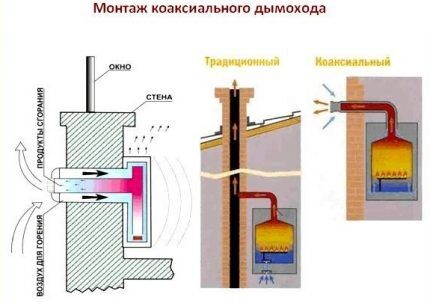
What happens in such a chimney during boiler operation? Hot combustion products move outward through the inner pipe, and in the opposite direction there is a parallel flow of fresh cold air. As a result, a completely natural heat exchange occurs: hot gases give off heat to the adjacent cold flow.
The air enters the combustion chamber already in a heated state, which increases the overall efficiency of the boiler, because there is no need to waste precious kilojoules on heating the air masses. At the same time, the temperature of the outer surface of the coaxial chimney is noticeably lower than when using a standard chimney pipe. This circumstance makes the design safer.
Another advantage of a coaxial chimney is that it is simpler boiler installationbecause you don't have to install the system forced ventilation. In addition, these structures have different requirements than those traditional chimneys. As a result, the combustion product removal system takes up less space.
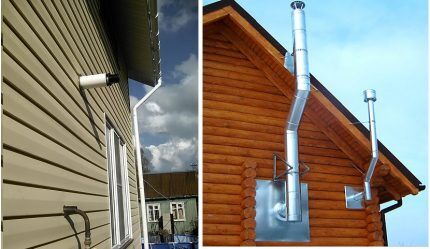
Coaxial chimneys are universal; they can be installed with gas boilers and with devices operating on liquid or solid fuel. Chimneys with different diameters are available for sale, which allows you to select suitable pipes for a particular boiler.
Installing a traditional chimney in an already constructed building is a rather difficult task. If chimney installation was not provided for during the design, it is necessary to go through the floors and roof or take the chimney outside.
A bulky structure can create problems both inside and outside the building. But coaxial designs are simpler and more compact. The installation of such a chimney on the outer wall looks laconic and will not spoil the appearance of the house.
Features of installation of coaxial chimneys
Chimneys of this type can be installed horizontally or vertically. The first option is preferable, which is considered simpler and takes up less space. In this case, a number of requirements must be observed:
- the distance from the pipe to the ground level on the outside of the house must be at least 2 m;
- the pipe must be located at least half a meter horizontally from windows, doors, ventilation holes, etc.;
- the same distance to these objects should be maintained vertically;
- if there is a window above the ventilation duct, the distance to its lower edge should be at least one meter;
- the free space in front of the coaxial pipe must be at least one and a half meters, i.e. there should be no walls, fences, pillars or other similar obstacles nearby;
- if there is no special device for collecting condensate, then the coaxial chimney pipe should be placed at a slope to the ground;
- the size of such a slope can vary between 3-12 degrees;
- it is not allowed to lead the chimney duct not to the street, but to another room or structure: entrance, basement, tunnel, arch, etc.;
- a distance of at least 20 cm should be maintained between the chimney elements and gas pipes if they pass nearby.
Separately, it is worth considering the situation when the outlet of the coaxial chimney pipe is located under a balcony or some kind of canopy. This is a completely acceptable situation, but the following point must be taken into account.
You need to mentally draw a circle in a plane perpendicular to the wall. The center of the circle will be the junction of the canopy and the wall, and the radius will be the length of the canopy or balcony.
The chimney pipe must protrude beyond this conditional boundary. It turns out that the closer to the canopy the hole for the chimney is, the longer the outer part of the pipe should be.
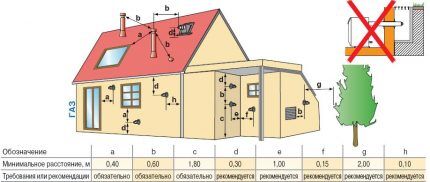
It is believed that the length of a coaxial chimney when using a horizontal installation scheme cannot be more than three meters. This is a general rule to which there are exceptions. For example, some Ferroli chimney models can be four or five meters long.
The set of materials for installing a coaxial chimney depends on the type of its location, but in general the list of elements may look like this:
- the chimney pipe itself;
- adapter for connecting the boiler to the chimney structure;
- elbow, tee, etc.;
- crimp clamps for reliable connection of elements.
Typically, the delivery kit for a coaxial chimney includes all the elements necessary for its installation. To pass a pipe through a wall, ceiling or roof, it is necessary to use fire-resistant gaskets. They will prevent overheating and fire of materials surrounding the chimney.
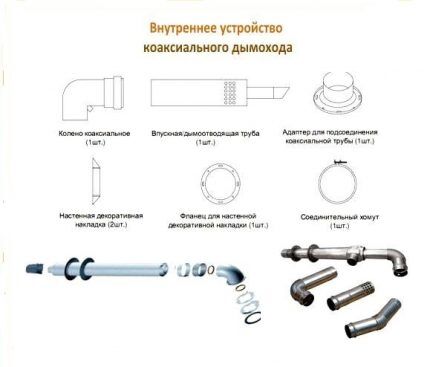
Here is one option: a hole is made in the wall and a sleeve from an asbestos-cement pipe is inserted into it. Then the space between the surface of the coaxial pipe and the sleeve is filled with asbestos cord. All elements of a coaxial chimney must be manufactured in an industrial environment and meet established standards.
It is not recommended to use homemade designs even for the adapter. Some amateur craftsmen try to increase the length of pipes using sealing tape and high temperature sealant. But this option does not stand up to criticism from a security point of view.
Basic installation requirements
The type of installation - horizontal or vertical - depends on the characteristics of the room in which the boiler will be placed. There should be no foreign objects in the space between the boiler and the wall into which the coaxial chimney will be installed; this is an important safety requirement.
In this case, the place where the chimney pipe exits the wall and the boiler pipe to which it is connected must be separated by at least 1.5 m vertically. The pipe should also have a slight slope - about 3 degrees, to ensure the outflow of moisture condensed on the surface of the communications.
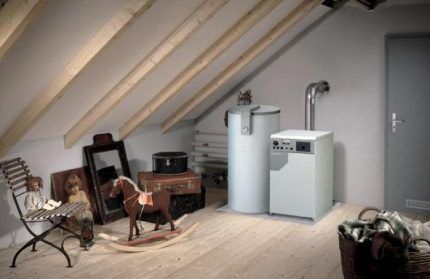
The next important parameter is the diameter of the pipe and boiler nozzle. They must match in size. Under no circumstances should it be allowed to install a pipe whose diameter is narrower than the dimensions of the outlet pipe of the heating device.
Before starting installation, you should carefully study the technical data sheet and boiler deviceto ensure that the dimensions of the pipe and chimney comply with established standards. The boiler pipe can be located on the top or side. It is believed that the upper location of the pipe simplifies installation.
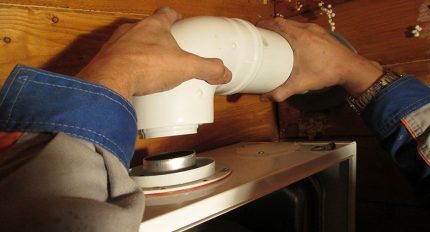
To connect a chimney pipe, an adapter in the form of a tee, elbow or a section of a regular pipe is usually used. At the same time, inside the adapter there should be no obstacles to the movement of gas and air masses.
If the length of the coaxial pipe has to be increased, care should be taken to ensure the tightness of the connection. For this purpose, crimp clamps are used. Adapters, elbows and other elements of the chimney are connected in the same way.
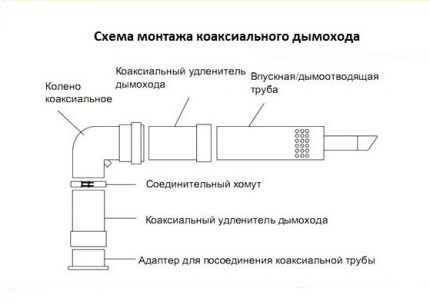
It is not recommended to carry out a design that includes more than two elbows. The total length of a coaxial chimney, consisting of several multidirectional sections, should be no more than three meters.
During the installation of a coaxial chimney, its lower elements are inserted into the upper and firmly fixed with clamps. This connection method allows for good traction. The individual elements must fit into each other to a depth of at least half the diameter of the structure in accordance with the requirements for coaxial chimneys.
For reliability, the place where the pipe exits the outer wall is blown with foam. Special decorative grilles are installed on top to make the installation site look attractive. The grille can be glued with a suitable adhesive, for example, liquid nails.
The part of the coaxial chimney laid indoors can be disguised, for example, using a plasterboard box:
Incorrect slope problem
Regarding the slope of the coaxial chimney pipe, the question may arise: where exactly should it be directed? Some experts argue that condensate should flow towards the boiler. According to other craftsmen, the slope should be done in the opposite direction so that moisture flows through the pipe to the ground. In both cases, reasonable arguments are given.
The option in which condensate droplets move as far as possible from the boiler seems quite logical. The firebox is protected from unnecessary moisture, which remains outside the house and naturally dissolves in the environment. Everything looks exactly like this until the ambient temperature drops below zero.
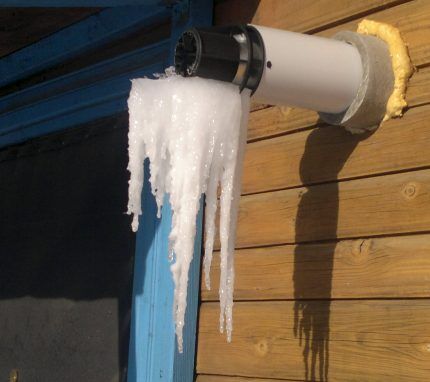
When frost sets in on a coaxial pipe installed with a slope towards the ground, condensate droplets freeze, forming an ice crust. Icing can be observed both on the outside of the chimney and in the space between two pipes of a coaxial structure.
This happens because the temperature of the outer circuit of this type of chimney is low, it is not enough to quickly melt the ice. As a result, ice deposits create obstacles to the normal flow of air into the firebox, as well as to the effective removal of combustion products.
And this reduces the efficiency of the device. Prolonged operation of the boiler with an icy coaxial chimney can even lead to significant equipment breakdowns.It turns out that in warm regions, where there is practically no frost even in winter, a coaxial chimney can be installed with a slope towards the ground.
In all other cases, it is recommended to slope the pipe towards the boiler, which usually corresponds to the recommendations of the manufacturers of these structures. What to do with the condensate that, with such an installation, will flow to the heating device?
It's simple, you need to install and use a special container to collect condensate. Such a condensate collector is a small device that copes with its tasks quite satisfactorily. The problem of chimney freezing can be partially solved by insulating it, but this measure does not provide one hundred percent guarantees.

Some craftsmen believe that condensate freezing in a coaxial chimney with a slope towards the ground can be prevented by shortening the inner pipe, but experts do not recommend changing the design yourself.
There is also another interesting opinion on the issue of icing of a coaxial chimney: the larger the diameter of the pipe, the lower the likelihood of condensate freezing. While craftsmen were debating the optimal slope of a coaxial chimney, manufacturers took care of creating a special kit.
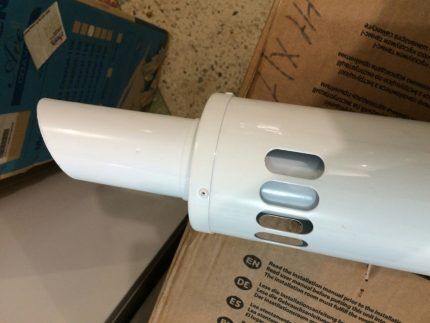
This design is resistant to icing and is designed for operation in the harsh Russian winter. This device is equipped with an extension nozzle for the gas outlet (i.e. internal) pipe. A narrow protective spiral is installed inside the nozzle. In this case, the holes for air intake along the edge of the outer pipe are located below.
Basics of choosing horizontal or vertical type
It is not always possible to fulfill all the requirements for horizontal installation of a coaxial chimney. Difficulties can be encountered if the room where the boiler is installed is very small. The outside of the building may also be problematic. For example, if there are windows close to each other.
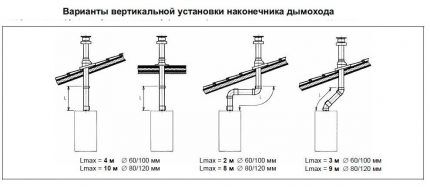
It also happens that the distance to neighboring buildings is too small to ensure normal draft of a coaxial chimney. If it is not possible to meet all the conditions for horizontal installation of the structure, preference should be given to vertical installation, i.e. bring the pipe through the roof.
When installing a coaxial chimney vertically, as with installing a traditional pipe, brackets are used. They allow you to keep the structure in the correct position and at a distance from the walls.
When venting a coaxial chimney through a roofing pie, special attention should be paid to fire safety issues. Insulating pipes should be used here, and the use of fire-resistant insulation is recommended.
Protective covers are also used to isolate the chimney from contact with other objects and materials. A small air gap should be left between the coaxial pipe and the overlap area, but the roof where the pipe exits is sealed very carefully. The junction of the pipe and the roof is covered with a thick protective casing.
Good ventilation device
It may seem that a heating device with a closed combustion chamber and the presence of a coaxial chimney relieves home owners from the need to provide the boiler room with normal ventilation. Indeed, air enters the firebox from the outside, and combustion products are removed through a reliable sealed channel.
However, it is still necessary to ventilate the room in which the boiler is installed. To begin with, normal air exchange will allow you to maintain an optimal level of humidity in the room, which prevents the development of corrosion processes and protects the equipment casing from destruction.
It should also be taken into account that any system can fail over time. If the boiler room is set up good ventilation, then in the event of a breakdown, a small amount of carbon monoxide will be removed from the room naturally. As a result, the risk of accidental carbon monoxide poisoning is significantly lower.
Conclusions and useful video on the topic
Video #1. The design of a coaxial chimney, its operating principle and installation features are presented in the following video:
Video #2. The complete set of an industrial coaxial chimney is shown here in detail:
Video #3. Coax Anti-Ice Kit Overview:
A coaxial chimney is a convenient and easy-to-install device that can significantly improve life in the home.But in order for such a chimney to function effectively, it is important to comply with the standards and requirements when installing it.
Did you have any questions while familiarizing yourself with the material, found any shortcomings, or would you like to talk about your own experience in assembling and using a coaxial chimney? Please post comments in the block located below the article. Leave posts with your opinion and photos on the topic.




Your horizontal coaxial chimney installation distances indicated in the figure are incorrect and do not comply with SNIP. For example, under a window: 1.0 m vertically to the windows when placing holes under them (to the bottom border). You have drawn 40 cm.
We have a floor fireplace 23, the chimney blows out. How to protect against blowing? And one more thing: condensation is running into the boiler room, I set up a bucket, I don’t know what to do, although the gas workers did.
Hello. We will be happy to help you if you define the problem in more detail, telling us in the comments what kind of “floor fireplace 23” you have (I immediately had many options) and what kind of chimney system you have. We are waiting for information.
I plan to install a WBN 6000-2B boiler with a power of 35 kW, the boiler room is located in the basement, there is no chimney, if it is discharged through the wall, the distance from the ground to the pipe is 1 m. However, I don’t understand the distance from the ground should be 2 meters before the pipe exits walls or from the ground to the place where the gases come out? Is it possible to remove the chimney according to the attached diagram from the boiler passport with a correction in red?
I plan to install a WBN 6000-2B boiler with a power of 35 kW, the boiler room is located in the basement, there is no chimney, if it is discharged through the wall, the distance from the ground to the pipe is 1 m. However, I don’t understand the distance from the ground should be 2 meters before the pipe exits walls or from the ground to the place where the gases come out? What if you put a chimney along the façade of a building?
I made a coaxial chimney myself and everything worked out. I couldn't be happier! But with a horizontal arrangement, the exit was under the window, and this is simply disgusting - I couldn’t figure out another installation option myself, so I had to contact a specialist. He completely dismantled the entire coaxial structure and made a traditional chimney. It cost a pretty penny, of course.
The length of the horizontal chimney is no more than 3 m, and then what is the best optimal minimum length? Thank you.
Hello. The optimal length of a coaxial chimney is calculated taking into account the recommendations of the chimney manufacturer, installation surface parameters, nearby buildings, trees, gas boiler data sheet and building codes/recommendations, as well as geosurveys.
And if the distance from my house to the boundary is 1.3, from the boundary to the neighbors’ summer kitchen, where the windows always open about 3 m, can I build such a wonderful structure? Or will there be problems with violation of SNIPs and sanitary standards?...
Hello, Ksenia. By “wonderful structure” do you mean a coaxial chimney?
I am still surprised that there are so few laws on coaxial chimneys and those that exist very vaguely reflect the standards for their installation.There is a set of recommendations for height and distance from your structure, it is true, but we need other parameters.
In fact, there are no legal distances and experts advise installing them in accordance with the device data sheet and recommend not violating sanitary standards for the dispersion of harmful substances in the atmosphere: “Calculation of the concentration of harmful emissions should be carried out when the boiler room is operating with thermal loads corresponding to the average temperature of the coldest month and the summer regime, and checked against the conditions of dispersion of harmful substances in the atmosphere, in accordance with the requirements given in [18] and agreed upon according to the conditions given in [19]«.
At the same time, it is very difficult to make aerodynamic calculations now, because we do not know what kind of terrain, structures, etc. you have there. You will still need to contact gas specialists for replacement; consult them and let them make calculations in accordance with your parameters and local legal standards.
By the way, there are standard recommendations that may be useful for you - from neighboring buildings - from 2 meters, provided that there are no other smoke exhaust devices within 3 meters, if there are, then from 3 meters.
A gas engineer told me on the phone that the coaxial pipe should be at least 10 meters from the neighboring house, but I didn’t find such information, what to do? Voronezh
Good afternoon. I have a question - what is the minimum distance I can install an external hood in a street wall to the coaxial pipe from the boiler? I get 26 cm horizontally and 17 cm vertically. The hood from the bathroom is 17 cm higher.
Hello!
Distance from the pipe to doors, windows, ventilation ducts, etc. vertically and horizontally should be at least 0.5 meters. If there is a window above the ventilation hole, the distance to its lower area should be at least a meter.
0.5m to the opening part of the window!?
Pavel, as the firefighters explained to us, we are talking about a window OPENING - not about a frame, glass, window... but a window opening. And even a blind window is considered a window from which a distance of 0.5 must be maintained. There are no links to the Rules and I haven’t looked for them yet. There were also proposals to cover up half the window, but privately (not at the reception) they advised not to do so. Unless this half of the window is removed for finishing.
Hello! I live in an apartment building, my neighbors in the building installed individual heating in their apartments in 2014. One common vertical external chimney was installed for five floors.
Now I'm doing ind. heating, I gave my neighbors money for the chimney and the project, and I ran into the following problem: on my piece of chimney there is no tee to connect the pipe from the boiler. That is, just an even piece of pipe.
I called the foreman who installs chimneys, he said that inserting a tee would cost 7,000 rubles. I was advised to hire a tinsmith who would simply cut a hole in the chimney and insert a pipe there that would connect to the pipe from the boiler. Is it possible to do this?
Hello. Since the neighbor installed a common chimney for everyone, you can simply crash into it. Why install a tee if you only need to connect the boiler to the chimney! This is just a waste of money, or the “masters” want to save money, as they say.You were given the right advice: call a tinsmith and cut into the chimney, especially since it was installed with this in mind.
Hello! Installed a coaxial chimney at the dacha. It so happens that the total length is 2m, and the main location of the 1.5m pipe runs along the street. I installed it in the spring, there was no frost yet. How will the chimney behave in cold weather? I plan to make a box like for drywall, insulating the outer part of the pipe with mineral wool. You can also run the heating cable along the pipe. Is it possible to do this? What do you think?
I immediately scrap the idea of a heating cable, it’s unsafe. The temperature in the chimney will reach 120-160 °C, the outer walls will also become very hot, so the cable may melt.
But regarding the box and insulation with mineral wool, that’s a great idea. Only as a material for the box, instead of drywall, I recommend using metal, even of the smallest thickness. It is more practical, more reliable and more durable. Drywall will quickly become unusable due to condensation, plus rain, the material is simply not designed for this.
A wall-mounted Ferroli boiler...a chimney from the same company...when installing a chimney, the connection between the 90° angle and the horizontal part is located inside the wall of the building...as I understand it, this is not safe...what should I do?
Good evening, please tell me about this question: I want to install a gas turbo heater with a coaxial chimney in a two-story house. There is a great desire to install it in the basement, but then the chimney exit is at a height of 1400 mm, which is unacceptable.Can I still install the column in the basement, but lead the chimney to the first floor into the kitchen and from the kitchen, using one 90-degree bend, go through the load-bearing outer wall to the street? Thank you.
Hello. The coaxial chimney comes out of the wall at a distance of 40 cm from the window and is pushed forward at a distance of 80 cm. Gas workers require that the chimney be rotated along the house and thus ensure the required distance according to SP 402.1325800.2018 - 50 cm. Allegedly, if it is along the house, then it is horizontal, but if the pipe goes perpendicular to the house at the same height, then it is no longer the horizon. Can you help with anything?
Good evening! I have a question, what should we do, please advise. Our neighbors built a garage before us. The garage is located only 60 cm from our border. The previous owners gave them the go-ahead, i.e. They signed an agreement for the border and sold us the house.
Now these neighbors have decided to use the garage space for a bathhouse. They installed a boiler, heated floors, and, naturally, the coaxial pipe was pulled into our yard in the area where we walk every day. The distance between their bathhouse and our fences is 60 cm. What should we do? There's a smell coming, it's impossible! They don't want to remove this pipe and move it to the other side. Please help me, where to go and what to do?
Hello! I liked it, but I have a lot of questions - I work at SVDGO, what should I do with the wind pressure zone and the wind rose? How does the chimney behave in these cases? Thank you.
Good afternoon, Vladimir. A coaxial chimney is installed only on boilers with a closed combustion chamber.
1.Fundamental to all boilers of this type, in contrast to an open chamber, is the forced removal of combustion products and complete isolation of the system from the user - this, Vladimir, is the answer regarding wind pressure.
2. On the issue of prevailing winds. If you look at it from the user's point of view, the attenuation and shutdown of the boiler due to the occurrence of reverse draft is solved by installing a wind protection. In most cases, it is a barrier made of tin, installed perpendicular to the facade at a distance of at least 40 cm from the exit, creating a “half-space”. In the product instructions, the manufacturer provides specific recommendations regarding the adverse effects of prevailing winds.
All over the world, coaxial pipes are easily installed in height starting from the level of a person’s waist and no problems arise during operation. As you know, we still do not have clearly defined standards for coaxial chimneys and all references are given to general provisions.
Good afternoon Boiler baxi eco life 24f closed chamber. Is it possible to make a coaxial chimney through an existing brick pipe h-5m, how to solve the issue with condensation or is it better to switch to a fence + 80 mm chimney
Hello! Very useful article. Is it possible to install a coaxial chimney for a gas condensing boiler in an existing chimney in brickwork? How to do it?
Hello. We can’t answer because we don’t see your “existing” chimney and we can’t determine what’s there and how yours works.
Hello! I have a Baxi Duo Tec Compact 1.24 boiler.In all installation diagrams of coaxial chimneys, a short vertical section (or without it at all) and a horizontal outlet into the wall up to 3 meters in length are drawn.
Is it allowed or not to make a vertical section of 2-2.5 meters, and then an 87 degree elbow and a horizontal exit into the wall of 75 cm?
SP 280.1325800.2016 - the rotation angle cannot be less than 90 degrees. The nature of the joint venture is advisory.
Here instructions to your boiler. About chimneys it starts from point 10.
As for the other nuances, the chimney passport must contain instructions for its installation. If you are interested in a do-it-yourself design, and not an existing product, then, as stated above in the article, we do not recommend doing it yourself, and even if some options are possible, we do not give advice on arranging home-made systems, since we do not want to incur even an indirect responsibility for your safety.
You are misleading people in vain. And what do you do with the incline? Perhaps you hang the boiler at an angle? 87⁰ is exactly the slope towards the street and I think that these are THREE! The degrees are not critical.
Hello! Before gasification of the house, on the advice of a representative of Gorgaz, they installed a turbo boiler in the basement. After gasifying the street, designers from the same city gas company refuse to accept the previously completed work, citing the fact that the outlet of the coaxial pipe is at a level of 1 m 20 cm from the ground.
Private house, pipe exit to the garden. They cannot explain the requirements for a pipe installation height of 2 meters. It is not possible to move the boiler; all communications are in the basement. What should I do? Thank you.
Hello.SP 42-101-2003 General provisions for the design and construction of gas distribution systems made of metal and polyethylene pipes, Appendix D (recommended):
«D. 21 The openings of smoke ducts on the facade of a residential building when removing combustion products from heating gas-using equipment through an external wall without installing a vertical channel should be placed in accordance with the installation instructions for gas-using equipment of the manufacturer, but at a distance of at least: - 2.0 m from ground level«.
SP 60.13330.2016: “7.3.3 The bottom of the opening for the external air intake device should be placed at a height of more than 1 m from the level of stable snow cover, determined according to data from hydrometeorological stations or calculations, but not lower than 2 m from the ground level«.
Hello. Please tell me, can a coaxial chimney enter the room adjacent to the furnace room and already in it carry out a vertical rise through the ceiling and then through the roof?
Hello, Zakhar. A coaxial chimney is the only possible and practice-tested solution for ensuring the removal of flue gases from the closed combustion chambers of turbocharged gas boilers. Paired with atmospheric equipment coaxial pipes are not used. They are not needed for arrangement liquid fuel And solid fuel units, because Their combustion chamber is open type.
Combustion products are removed through the coaxial chimney and oxygen is injected, which otherwise does not have access to the closed chamber.
The basic requirements for the design and installation of all types of chimneys are contained in the documents: GOST R 53321-2009 “Heat-generating devices operating on various types of fuel” and SP) 60.13330.2012 “Heating, ventilation and air conditioning”.
1) A smoke channel whose length is more than 6 meters or with a deviation from the vertical of more than 30 degrees must have cleaning elements.
2) The lower part of the smoke duct must end in a structural pocket of at least 250 mm in size, which serves to collect and remove ash and condensate.
3) The length of the smoke duct from the grate to the entrance must be at least 5 meters. This requirement does not apply to coaxial systems at all, because they can be led through the wall directly to the street.
4) The height of ordinary pipes, which are installed at a distance equal to or greater than the height of the structure protruding above the roof, is accepted:
- from 50 cm - above a flat roof;
- from 50 cm - above the ridge of the roof, as well as above the parapet when installing a pipe up to 1.5 m from the ridge or this parapet;
- not lower than the roof, parapet when installing the pipe at a distance of 1.5-3 meters from the ridge;
5) It is possible to provide chimney outlets at an angle of up to 30 degrees to the vertical with a distance of no more than 1 meter. In this case, the inclined areas must be smooth and have the same cross-section.
6) The distance from the outer planes of chimneys to elements of the rafter system made of combustible materials should be at least 250 mm.
If the above conditions are met, the chimney can enter not into the firebox, but into the adjacent room. Both conventional and coaxial chimneys should be laid so that they do not cross residential premises.The photo shows an example of connection to a root pipe installed on a separate foundation.
Good afternoon. As I understand it, the requirements for the location of chimneys on the roof also apply to vertical coaxial ones?
Good afternoon Question about a set of coaxial pipes. At the moment it is planned to install Baxi Ecofor for heating. I am attaching the diagram. I'm worried about the length of the pipe, it seems that the norms are being violated.
Does it make sense to include an adapter from 60/100 to 80/125 in the circuit to extend the pipe?
Hello. What should be the minimum length of a coaxial chimney at the exit from the wall to the outside?
Damir. Surprisingly, such a simple question does not have a clear answer. The minimum length of a coaxial chimney is not limited by regulations. The shorter the outlet length, the greater the impact of the flue gases on the wall (the wind will periodically blow it in). Condensation will form on the wall. On the other hand, the longer the pipe on the street, the higher the risk of freezing of the area located outside. From practice, we recommend approximately 30 cm from the wall to the point of air inflow.
In our multi-storey building, on the 6th floor, a coaxial pipe from a gas boiler is routed into a common chimney, dia. 500 made of special plastic. We have developed a kitchen project that involves moving the gas boiler upward. It is impossible to move the insert.. Is it possible for a coaxial pipe to go from the boiler to the chimney duct with a counter-slope of 45 degrees? Thank you
Hello! We have a Navien boiler with a closed chamber and a coaxial chimney; the chimney is built into a brick channel through which air enters the boiler. An ash pit with a lid is located under the boiler in the chimney. Here’s a question: when you close the ash pan with a lid, the wall around the hole in the ash pan begins to get very wet, if you open it it doesn’t get wet, but it shouldn’t always be open and, in addition, through the ash pan, if you stretch your hand, the chimney pipe is all wet. You need a condensate drain, as I understand it?
In my case, and I live in an apartment building, on the 2nd floor, the neighbor below installed a coaxial pipe a meter under my window. During installation, he didn’t ask me if I would have any inconvenience and now the combustion products are coming straight into my window, causing me great discomfort and the prevailing winds are also in my direction. What should I do?
Since condensate freezes in the gratings of the plastic head, preventing further outflow of condensate and the formation of ice inside between the walls of the pipes, is it even possible to remove the head, at least for the winter? And operate the boiler without a head?
Good morning. I have a wall-mounted boiler Immergas eolo mitos 24 installed. The chimney is horizontal, but the angle is 90 degrees. It was not installed immediately at the outlet of the boiler, but first a vertical section of 40 cm, then an angle of 90 and then a straight section of about 1.5 m to the street. This winter, the boiler began to go out, giving error E27, when disassembling it, it turned out that the tube from the pressure switch to the fan was clogged, they cleaned it, everything worked, but after 2 hours it goes out again, what could it be?
The chimney is installed along the wall
I need to make a rise of 0.5 m from the boiler and a horizontal section of about 2 meters inside the room to the exit through the wall of a private house. Is this installation possible?
I live in an apartment building, on the 2nd floor, the neighbor below installed a coaxial pipe less than 05 meters under my window.
Now the combustion products are coming straight out my window, causing me great discomfort.. What should I do?
Contact the gas service, this is a serious violation.
I would like to know the maximum length of the chimney from a coaxial gas heater
Vologda Mezhregiongaz does not approve the use of a coaxial chimney, refers to SP 281 clause 11.2.5 and forces the use of a conventional vertical chimney. Boiler for heating an industrial warehouse with a closed combustion chamber. How to defeat them?
Hello! I want to add a veranda to the kitchen in a private house. The gas exhaust pipe from the boiler is in the way.
Is it possible to move this pipe up so that it exits through the roof gable?
Good afternoon. There are no prohibitions here. Exit the chimney wherever it is convenient for you. After all, before this the exit was through the wall. You'll just have to make holes in the ceiling and lead the pipe into the attic. And already through the gable to the street. The main thing here is to comply with fire safety rules, especially when passing through the ceiling.
Please tell me, is this the normal height of the chimney outlet?
Hello, I am asking for advice, in a private house, a floor-standing, old-style cast-iron gas boiler was installed; combustion products were discharged through a chimney to the roof.Now I am installing a 2-circuit boiler, with a coaxial system for the exhaust of combustion products and air intake, the question is: can I bring the coaxial pipe into the existing chimney, or do I need to make holes in the wall and lead the horizontal pipe to the street?
Hello. A wall-mounted Baxi gas boiler is installed in a private house. The coaxial chimney extends approximately 40 cm from the wall. The chimney is anti-icing and windproof. The problem is that condensation forms on the pipe coming out of the boiler into the wall and connecting to the chimney. How can this be fixed? The angle of inclination of the chimney is maintained. And there is condensation inside the visit, not outside.
Hello! I want to change the usual AOGV to a boiler with a closed combustion chamber. Is it possible to insert a coaxial chimney into an existing sandwich?
Hello. I have a private wooden house. What size of opening for a coaxial pipe is provided according to the standard through the wall.